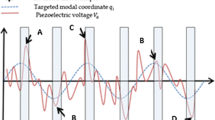Abstract
This paper deals with semi-active vibration reduction by means of piezo-actuators shunted to time-variant impedances. Particularly, attention is focused on the Synchronized Switch Damping on Inductance technique applied to single mode control in presence of a random disturbance. Drawbacks of the mentioned method are evidenced, showing that sometimes it can fail. Therefore, an alternative method (which actually is an evolution of SSDI) is proposed and its effectiveness is proved numerically through a model. Such a model is validated experimentally within the paper.
Access this chapter
Tax calculation will be finalised at checkout
Purchases are for personal use only
Similar content being viewed by others
References
Hagood NW, von Flotow A (1991) Damping of structural vibrations with piezoelectric materials and passive electrical networks. J Sound Vib 146:243–268
Neubauer M, Han X, Schwarzendahl SM (2011) Enhanced switching law for synchronized switch damping on inductor with bimodal excitation. J Sound Vib 330:2707–2720
Behrens S, Moheimani SOR, Fleming AJ (2003) Multiple mode current flowing passive piezoelectric shunt controller. J Sound Vib 266:929–942
Lefeuvre E, Badel A, Petit L, Richard C, Guyomar D (2006) Semi-passive piezoelectric structural damping by synchronized switching on voltage source. J Intell Mater Syst Struct 17:653–660
Cigada A, Manzoni S, Redaelli M, Vanali M (2012) Optimization of the current flowing technique aimed at semi-passive multi-modal vibration reduction. J Vib Control 18:298–312
de Marneffe B, Preumont A (2008) Vibration damping with negative capacitance shunts: theory and experiment. Smart Mater Struct 17:article number 035015
Manzoni S, Moschini S, Redaelli M, Vanali M (2012) Vibration attenuation by means of piezoelectric transducer shunted to synthetic negative capacitance. J Sound Vib 331:4644–4657
Guyomar D, Badel A (2006) Nonlinear semi-passive multimodal vibration damping: an efficient probabilistic approach. J Sound Vib 294:249–268
Corr LR, Clark WV (2001) Energy dissipation analysis of a piezoceramic semi-active vibration reduction. J Intell Mater Syst Struct 12:729–736
Richard C, Guyomar D, Audigier D, Ching G (1999) Semi-passive damping using continuous switching of a piezoelectric device. Proc SPIE – Int Soc Opt Eng 3672:104–111
Richard C, Guyomar D, Audigier D, Bassaler H (2000) Enhanced semi passive damping using continuous switching of a piezoelectric device on an inductor. Proc SPIE – Int Soc Opt Eng 3989:288–299
Moheimani SOR, Fleming AJ (2006) Piezoelectric transducers for vibration control and damping. Springer, London
Preumont A (2006) Mechatronics: dynamics of electromechanical and piezoelectric systems. Springer, Dordrecht
Agneni A, Balis Crema L, Sgubini S (2003) Damping by piezoceramic devices with passive loads. Mech Syst Signal Process 17:1097–1114
Chérif A, Richard C, Guyomar D, Belkhiat S, Meddad M (2012) Simulation of multimodal vibration damping of a plate structure using a modal SSDI-Max technique. J Intell Mater Struct 23:675–689
Author information
Authors and Affiliations
Corresponding author
Editor information
Editors and Affiliations
Rights and permissions
Copyright information
© 2014 The Society for Experimental Mechanics
About this paper
Cite this paper
Berardengo, M., Manzoni, S., Redaelli, M., Vanali, M. (2014). SSDI Technique Evolution to Improve Attenuation Performances with Random Disturbances. In: Allemang, R., De Clerck, J., Niezrecki, C., Wicks, A. (eds) Topics in Modal Analysis, Volume 7. Conference Proceedings of the Society for Experimental Mechanics Series. Springer, New York, NY. https://doi.org/10.1007/978-1-4614-6585-0_10
Download citation
DOI: https://doi.org/10.1007/978-1-4614-6585-0_10
Published:
Publisher Name: Springer, New York, NY
Print ISBN: 978-1-4614-6584-3
Online ISBN: 978-1-4614-6585-0
eBook Packages: EngineeringEngineering (R0)




